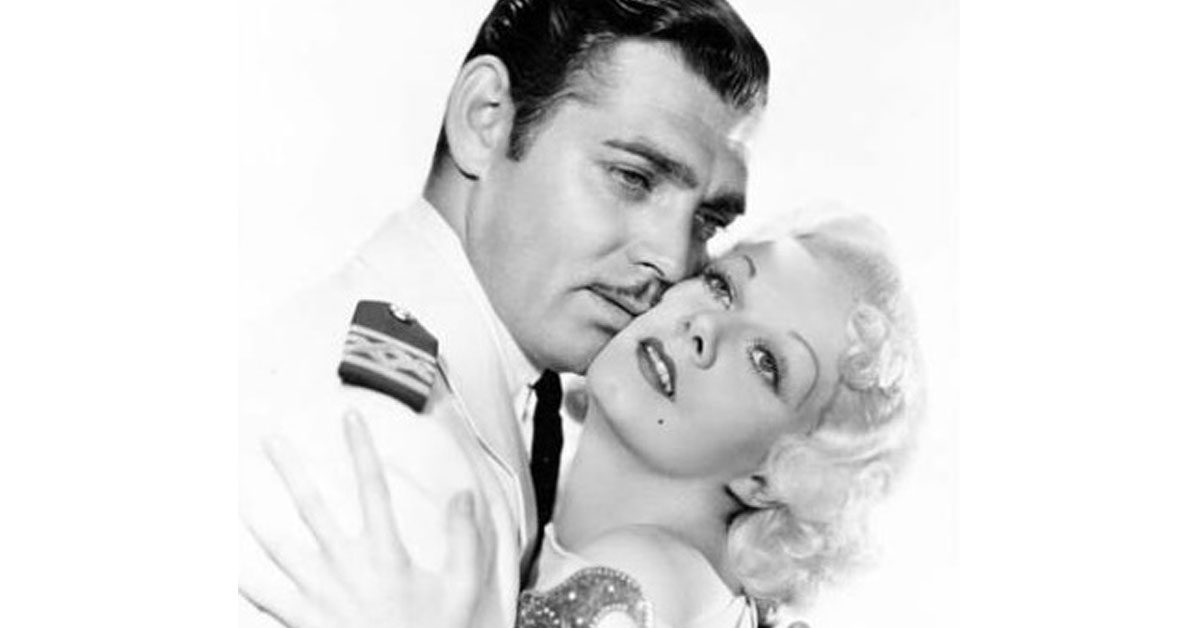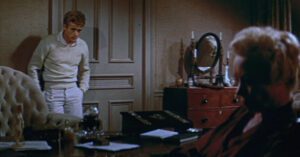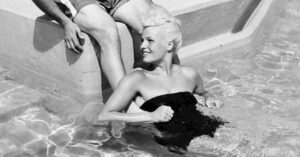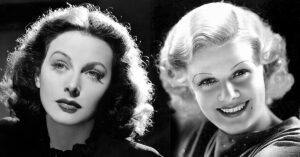Based on a slam bang adventure novel (that the Hays Office originally vetoed as fetid and objectionable source material for motion pictures based on the interracial love affair and the illegitimate child which it produced), M-G-M’s China Seas (1935) was Jean Harlow‘s third film with Wallace Beery, and her fourth with Clark Gable. They were real friends, and between scenes, she called him “Clarkie.”
Since Irving Thalberg was the producer, China Seas was grandiose in scope and complex to put on film. He employed the top talent in every department, and persevered when the guardians of morality at the Hayes Office rejected script after script. Development went on and on, keeping the production in Hollywood’s news.
These were huge stars at the time, and Metro-Goldwyn-Mayer was the top studio, one that pulled out all the stops in promoting this picture. From the pressbook for China Seas, here is some of the “catch-lines” copy suggested for this film’s exploitation campaign:
“Gable … as the hard-bitten young skipper of an imperiled steamer! Harlow … as a charmer from the ports of the orient, who every man wanted! Beery … as the sinister ‘brains’ of a modern pirate gang! These three … in a powerful romance of fierce loves … bitter hates … dangerous intrigues! They laughed at death … and drank of life …in the loneliest part of the seven seas!”
Louis B. Mayer had thought he was punishing Clark Gable in 1934 when he loaned Gable to lowly Columbia Pictures (which today, as Sony Pictures, now owns the former M-G-M lot) for It Happened One Night. Instead, Gable won an Oscar. He came back to Metro empowered.
Behind the scenes on China Seas, he threw his weight around, displaying temperament and tantrums. He was defying Mayer, and it shows in his performance as a snarling, two-fisted rogue of the orient. The water scenes were hazardous, and Gable’s stuntman was nearly killed in one sequence. Yet Gable refused to be doubled in another dangerous scene involving runaway steamrollers and some powerful dump tanks holding tons of raging water just out of camera range.
Meanwhile Jean Harlow was at the zenith of her career, playing a tropical trollop, brazen and braless, exhibiting emotionalism and unrestrained hysteria that the part called for — completely the opposite of who she really was.
By 1935 too much bleaching had ruined Harlow’s hair. It was falling out. She wore a wig in China Seas, except for one short scene where she had to get soaked in a typhoon. Her darker, shorter, damaged hair is then visible, but she covers up quickly with a towel.
Fourth billed in China Seas was Rosalind Russell. In her autobiography, she says nothing about China Seas; it is merely an excuse to discuss Jean Harlow, whom she thought was perfectly formed, and might be mistaken for a preadolescent. “I loved her,” Russell wrote, “and oh, she was a stunning creature.”
In making China Seas, Irving Thalberg said, “To hell with art this time. I am going to produce a picture that will make money. ” And so he did. Despite being banned in Malaya and Singapore, a tidal wave of worldwide revenue sailed in — $2.8 million, which was huge for that time. The resulting net profit was $653,000 for a return on investment of 57%.
The New York Post notice praised the picture as “a lusty and tempestuous record of romance and bloodshed in tropic waters.”




